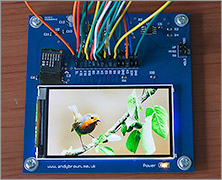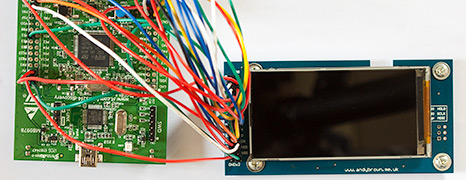Welcome to another in my series of cellphone LCD reverse-engineering articles. In this article I’m going to present everything you need to hook up the high-resolution 640×360 LCD from the Sony Ericsson U5 Vivaz to your project. About the phone and LCD The Sony Ericsson U5 Vivaz LCD...
Reverse engineering the LG KF700 480 x 240 widescreen cellphone LCD
posted by Andy
Hello and welcome to my first published non-Nokia cellphone LCD reverse-engineering effort. All my articles in this series focus on bringing you all of the details that you would need in order to connect a low-cost cellphone LCD to an MCU for use in your own projects. This one is no different. I will explain the pinout and the signals. I will tell you about the connector and where you can buy it and I will tell you about the controller IC and of course I will give away the complete source code driver for that controller. Let’s get started. The LG KF700 The KF700 was released in 2008 and is now a discontinued model. It featured a 3.0...
A generic optimised 16-bit LCD adaptor for the Arduino
posted by Andy
There are many TFT modules available on the market that are designed to connect directly to an MCU to provide a full colour graphical display, just search ebay for “tft module” to see what I mean. Unfortunately for Arduino users the majority of these modules expose a 16-bit...
Reverse engineering the Nokia E73 QVGA LCD
posted by Andy
Readers with a keen memory will no doubt recall that I said that the N93 would probably be the last of the Nokia QVGA LCDs that I attempt to reverse engineer. However probably is not definitely and one day whilst browsing ebay my finger slipped and next thing I knew I’d got myself an...
Arduino Mega 512K SRAM in shield format
posted by Andy
Some time ago now I presented the design, development board and software driver for an add-on to the Arduino Mega that gave it access to 448Kb of additional SRAM arranged in 8 banks of 56Kb. My design was realised by a compact add-on board that plugged into the relevant block of pins on the...
Generic Nokia LCD hacking board
posted by Andy
Over the course of the last few months I’ve been presenting schematics and PCBs that you can use to attach various Nokia LCDs to popular microcontrollers. Today I’m going to go one step further and present the generic board that I use for hacking any Nokia LCD that happens to have...
Reverse engineering the Nokia N93 QVGA LCD
posted by Andy
Welcome to what will probably be the last in the series of articles in which I reverse engineer one of the Nokia QVGA cellphone displays from the pre-smartphone era. I think that by now I’ve covered every possible aspect of these incredibly cost effective little displays and hopefully...
Reverse engineering the Nokia N95 8Gb QVGA LCD
posted by Andy
In this, the latest instalment of my Nokia QVGA TFT reverse engineering series, I will take on the 2.8 inch 24-bit TFT that is designed to work with the Nokia N95 8Gb mobile phone. Read on to see how it worked out. Background In the first of my reverse engineering articles I tackled the Nokia 2730 display. I successfully discovered enough of the command set to write a driver for the Arduino and the STM32. Flush with that success I moved on to tackle the Nokia 6300 and the Nokia N82. I was lucky in that these two shared the same pinout and command set as the 2730 so I could produce a development board with little difficulty. The N95...








